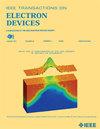Modulating Self-Heating Effects in GaN HEMTs Using Slant Field Plate
IF 2.9
2区 工程技术
Q2 ENGINEERING, ELECTRICAL & ELECTRONIC
引用次数: 0
Abstract
The self-heating effect in electronic devices can lead to localized hotspots, adversely affecting their performance and reliability, particularly in high-power-density devices like gallium nitride (GaN) high-electron-mobility transistors (HEMTs). In addition to enhancing heat dissipation, reducing heat generation through structural design can effectively modulate self-heating effects. This study investigates the modulation effect of an asymmetric slant field plate (FP) on self-heating in GaN HEMTs, using electro-thermal simulations based on the drift-diffusion model. Additionally, Monte Carlo (MC) simulations are employed to examine the influence of the slant FP on phonon ballistic transport under non-Fourier heat conduction. Results show that the slant FP smooths the potential distribution and reduces the maximum electric field intensity in the channel, thereby decreasing the maximum heat generation density. With a slant angle of 6° and an FP length of 1200 nm, the maximum heat generation density is reduced by 50%, and the hotspot temperature rise is lowered by 16%. By adjusting the characteristic size of the heat source, the slant FP further reduces near-junction thermal resistance, achieving the hotspot temperature reduction of over 30% under non-Fourier heat conduction. This work aims to deepen the understanding of self-heating effects in HEMT devices and explore a potential thermal management strategy.利用斜场板调节 GaN HEMT 中的自加热效应
电子器件中的自热效应可能导致局部热点,对其性能和可靠性产生不利影响,特别是在高功率密度器件中,如氮化镓(GaN)高电子迁移率晶体管(hemt)。除了增强散热外,通过结构设计减少发热量可以有效调节自热效应。本研究利用基于漂移-扩散模型的电热模拟,研究了不对称斜场板(FP)对GaN hemt自加热的调制效应。此外,利用蒙特卡罗(MC)模拟研究了非傅立叶热传导条件下,倾斜FP对声子弹道输运的影响。结果表明,倾斜的FP平滑了通道内的电位分布,降低了通道内的最大电场强度,从而降低了最大产热密度。当倾角为6°,FP长度为1200 nm时,最大产热密度降低了50%,热点温升降低了16%。通过调整热源的特征尺寸,倾斜FP进一步降低了近结热阻,实现了非傅立叶热传导下热点温度降低30%以上。这项工作旨在加深对HEMT器件自热效应的理解,并探索潜在的热管理策略。
本文章由计算机程序翻译,如有差异,请以英文原文为准。
求助全文
约1分钟内获得全文
求助全文
来源期刊

IEEE Transactions on Electron Devices
工程技术-工程:电子与电气
CiteScore
5.80
自引率
16.10%
发文量
937
审稿时长
3.8 months
期刊介绍:
IEEE Transactions on Electron Devices publishes original and significant contributions relating to the theory, modeling, design, performance and reliability of electron and ion integrated circuit devices and interconnects, involving insulators, metals, organic materials, micro-plasmas, semiconductors, quantum-effect structures, vacuum devices, and emerging materials with applications in bioelectronics, biomedical electronics, computation, communications, displays, microelectromechanics, imaging, micro-actuators, nanoelectronics, optoelectronics, photovoltaics, power ICs and micro-sensors. Tutorial and review papers on these subjects are also published and occasional special issues appear to present a collection of papers which treat particular areas in more depth and breadth.
 求助内容:
求助内容: 应助结果提醒方式:
应助结果提醒方式:


